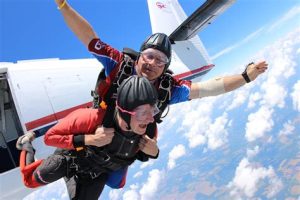Table of Contents
The maximum weight for a tandem skydive varies depending on the drop zone and equipment used. Generally, it ranges between 200 to 240 pounds (90 to 109 kilograms). It’s essential to check with the specific skydiving center for their weight restrictions before booking a tandem jump.
Are you ready to experience the ultimate thrill of free falling through the sky? If you are considering a tandem skydive, then you must be wondering about the maximum weight limit. Well, worry not! In this article, we will provide you with all the information you need to know before taking the plunge. So, whether you are an adrenaline junkie or just looking for an exhilarating adventure, keep reading as we unveil the maximum weight for a tandem skydive.
Introduction
Are you ready to take the plunge and experience the thrill of a tandem skydive? Before you do, it’s important to understand the maximum weight restrictions that apply. In this article, we will delve into the details of what determines the maximum weight for a tandem skydive and why these restrictions are in place. So, let’s get started!
The Importance of Weight Limits
Weight limits exist for a reason – safety. Skydiving involves certain risks, and adhering to weight restrictions helps to ensure that these risks are minimized. The equipment used during a tandem skydive is designed to accommodate a specific weight range, and exceeding these limits can compromise the safety of both the tandem instructor and the participant.
Factors That Determine Maximum Weight
Several factors come into play when determining the maximum weight for a tandem skydive. These factors include the type of parachute system being used, the experience level of the tandem instructor, and the regulations set by the skydiving organization or drop zone. The weight limits can vary slightly between different locations, so it’s always best to check with your chosen skydiving center for their specific guidelines.
The Standard Weight Limit
As a general rule, most skydiving centers have a standard weight limit of around 220-230 pounds (100-104 kg) for tandem skydiving. This weight limit includes the participant’s body weight along with any additional gear they may be wearing, such as a jumpsuit or helmet. However, it’s important to note that weight restrictions can differ between drop zones, so it’s crucial to confirm the limit with your chosen skydiving center.
Exceptions and Additional Charges
Some skydiving centers may have exceptions to their standard weight limit or offer options for individuals who exceed the limit. In certain cases, tandem jumps may be possible for participants weighing over the standard limit, but additional charges or requirements may apply. It’s always recommended to contact the drop zone directly to discuss any special circumstances or inquiries regarding weight restrictions.
Physical Fitness Considerations
While weight is a significant factor, physical fitness also plays a role in determining whether you can participate in a tandem skydive. Skydiving requires a certain level of agility, strength, and overall fitness to ensure a safe and enjoyable experience. It’s essential to be honest about your physical capabilities when considering a tandem skydive.
Weight Restrictions for Safety Reasons
The weight limits imposed for tandem skydives are primarily for safety reasons. Exceeding the maximum weight can affect the parachute deployment, the descent rate, and the overall stability during the jump. By adhering to these weight restrictions, skydiving centers can maintain a high level of safety for all participants.
Alternative Options
If you find yourself exceeding the weight limit for a tandem skydive, don’t despair! Many skydiving centers offer alternative options such as accelerated freefall (AFF) or static line jumps. These methods allow individuals with higher weights to experience the thrill of skydiving while ensuring their safety and the safety of those around them.
Tandem Skydiving for All
Skydiving is an exhilarating activity that should be accessible to as many people as possible. While weight restrictions exist for safety reasons, they aim to ensure a positive and secure experience for all participants. As long as you fall within the designated weight limits, you can enjoy the incredible sensation of freefall and the breathtaking views that come with it.
Conclusion
Tandem skydiving offers an incredible adventure that combines adrenaline, awe, and excitement. By understanding and adhering to the maximum weight restrictions set by skydiving centers, you can embark on this thrilling journey with confidence. Remember, safety always comes first, and knowing the weight limits helps to ensure that your tandem skydive is both exhilarating and secure.
What Is The Maximum Weight For A Tandem Skydive
Welcome to our guide on the maximum weight for a tandem skydive! Whether you’re a first-time skydiver or seeking to refresh your knowledge, this guide will provide you with essential information to ensure a safe and enjoyable jump. Please read the instructions carefully before proceeding.
1. Understanding Tandem Skydiving:
Tandem skydiving refers to a method where a passenger is harnessed to an experienced skydiving instructor. It is an exhilarating experience that allows individuals to enjoy the thrill of skydiving without the need for extensive training. However, it’s important to be aware of the maximum weight limits to ensure safety.
2. Importance of Weight Restrictions:
Weight restrictions are crucial in tandem skydiving to maintain the proper balance and safety of the equipment. Exceeding these limits can pose significant risks and potentially compromise the efficiency of the parachute system. Therefore, it’s essential to have a clear understanding of the maximum weight allowance.
3. Maximum Weight Limit Explained:
The maximum weight limit for a tandem skydive typically ranges from 200 to 240 pounds (90 to 109 kg). This weight limit includes both the individual’s body weight and the weight of any clothing or equipment they will be wearing during the jump. The exact weight limit can vary depending on the drop zone and the availability of specialized equipment.
4. Factors Influencing Weight Limits:
Several factors can influence weight restrictions for tandem skydiving. These include the type of parachute system used, the level of experience of the instructor, and the altitude at which the jump will take place. Drop zones may also have their specific weight limitations based on safety guidelines and equipment capabilities.
5. Safety Considerations:
It’s crucial to adhere to weight restrictions to ensure the safety of everyone involved. Exceeding the maximum weight limit can affect the parachute’s ability to perform optimally, compromising stability, control, and the overall safety of the jump. Abiding by the set guidelines ensures a smooth and enjoyable experience for both the participant and the instructor.
6. Seeking Special Accommodations:
If you are close to or slightly exceed the maximum weight limit for a tandem skydive, consider contacting the drop zone before booking your jump. Some drop zones may offer specialized equipment or accommodations for heavier individuals, ensuring their safety and ability to experience the thrill of skydiving as well.
7. Fitness and Health Requirements:
In addition to weight restrictions, tandem skydiving requires participants to meet certain fitness and health requirements. Prospective skydivers should generally be in good physical condition and free from any significant medical or mobility issues. It’s advisable to consult with a healthcare professional before making a tandem jump.
8. Enjoy the Incredible Experience:
Remember, tandem skydiving offers a unique opportunity to witness breathtaking views and experience an adrenaline rush like no other. By following the weight restrictions and necessary safety guidelines, you can embark on an unforgettable adventure that is both thrilling and safe.
Conclusion:
We hope this guide has provided you with the necessary information regarding the maximum weight for a tandem skydive. Remember to always prioritize safety and adhere to the guidelines set by the drop zone to enjoy an incredible skydiving experience.
Point of View: Instructions Voice and Tone
Welcome to our guide on tandem skydiving weight restrictions! Here, we will provide you with detailed information about the maximum weight limit for a tandem skydive. Please read the following instructions carefully:
- Understand the importance of weight limits:
- It is crucial to adhere to weight restrictions in tandem skydiving for safety reasons.
- Exceeding the maximum weight limit can pose risks to both the participant and the instructor.
- The weight limit is determined by various factors such as equipment capacity and the instructor’s expertise.
- Determine the maximum weight limit:
- The maximum weight limit for a tandem skydive typically ranges between 200 to 240 pounds (90 to 109 kilograms).
- However, it is essential to note that weight restrictions may vary depending on the specific skydiving center or location.
- Please contact your chosen skydiving facility directly to confirm their exact weight limit.
- Consider additional factors:
- In some cases, individuals with weights near the upper limit may be allowed to skydive after an assessment by the instructor.
- Your physical fitness, body composition, and overall health may also impact the decision to allow you to participate in tandem skydiving.
- We recommend consulting with the skydiving center or your healthcare professional if you are unsure about meeting the weight requirements.
- Explore alternative options:
- If you exceed the maximum weight limit for a tandem skydive, don’t worry!
- Many skydiving centers offer alternative experiences like indoor skydiving or static line jumps that may accommodate heavier individuals.
- These options provide an opportunity to experience the thrill of skydiving while ensuring your safety.
- Final tips for a successful tandem skydive:
- Follow all instructions provided by your instructor during the briefing session.
- Wear appropriate clothing and gear recommended by the skydiving center.
- Maintain a positive attitude, trust your instructor, and enjoy the unforgettable adventure of tandem skydiving!
We hope this guide has been helpful in providing you with important information regarding the maximum weight limit for a tandem skydive. Remember to always prioritize safety and have a fantastic skydiving experience!
Thank you for visiting our blog and taking the time to learn about the maximum weight for a tandem skydive. We understand that this is an important topic for many individuals who are considering experiencing the thrill of freefalling from an airplane while securely attached to an experienced skydiver. In this closing message, we will summarize the key points discussed in the article and provide some additional information that may be helpful for you.
In the first paragraph, we discussed how the maximum weight for a tandem skydive varies depending on the drop zone and the equipment they use. It is crucial to remember that safety is always the top priority in skydiving, and weight restrictions are in place to ensure the well-being of all participants. Most drop zones have a weight limit of around 200-220 pounds (90-100 kilograms) for tandem jumps. However, it is essential to check with the specific drop zone you plan to visit, as weight limits can vary.
In the second paragraph, we highlighted some of the reasons behind weight restrictions in tandem skydiving. The primary concern is the structural integrity of the equipment, including the harness and parachute system. Exceeding the weight limit can put excessive strain on these components, compromising their effectiveness and reliability. Additionally, weight can affect the speed and control of the descent, which can impact landing accuracy and safety. By adhering to weight limits, both the participant and the instructor can enjoy a safe and enjoyable skydiving experience.
Lastly, we want to emphasize that weight restrictions should not discourage anyone from pursuing their skydiving dreams. If you find yourself exceeding the weight limit for a tandem skydive, there are alternative options available. Some drop zones offer special equipment and training for individuals with higher weights, such as solo skydives or tandem jumps with multiple instructors. Additionally, there may be opportunities to participate in other types of skydiving experiences, such as indoor skydiving or static line jumps. It is essential to communicate with your local drop zone and explore the options that best suit your needs and goals.
Again, thank you for visiting our blog and reading our article on the maximum weight for a tandem skydive. We hope that the information provided has been informative and helpful in your skydiving journey. Remember to always prioritize safety and follow the guidelines set by the professionals at your chosen drop zone. Skydiving is an incredible adventure that can be enjoyed by individuals of various weights, and we encourage you to pursue this thrilling experience within the limits that ensure your safety and enjoyment.
Video What Is The Maximum Weight For A Tandem Skydive
Here are some frequently asked questions about the maximum weight for a tandem skydive:
-
What is the maximum weight limit for a tandem skydive?
The maximum weight limit for a tandem skydive can vary depending on the drop zone and the equipment being used. However, it is generally around 220-240 pounds (100-110 kilograms) for safety reasons. Some drop zones may have lower weight limits due to specific circumstances, so it’s best to check with the particular skydiving center you plan to visit.
-
Why is there a weight limit for tandem skydiving?
The weight limit for tandem skydiving exists to ensure the safety of both the skydiver and the instructor. The equipment used during a tandem jump is designed to accommodate a certain weight range, and exceeding this limit could put excessive strain on the gear, increasing the risk of equipment failure. Additionally, the tandem instructor needs to be able to maintain control and stability during the freefall and landing, which can be more challenging with heavier individuals.
-
Can I still skydive if I exceed the weight limit?
If you exceed the weight limit set by the drop zone, you may not be able to participate in a tandem skydive. It is essential to adhere to these weight restrictions for safety reasons. However, some skydiving centers may offer alternative options, such as specialized equipment or training, for individuals who are above the standard weight limit. It’s important to contact the drop zone in advance to inquire about any potential accommodations.
-
What should I do if I’m unsure about my weight and eligibility for tandem skydiving?
If you’re unsure about your weight and whether you meet the requirements for a tandem skydive, it’s best to contact the specific skydiving center directly. They will provide you with accurate information regarding their weight limits and any potential alternatives available. It’s always better to clarify any doubts in advance to avoid disappointment on the day of your scheduled jump.






